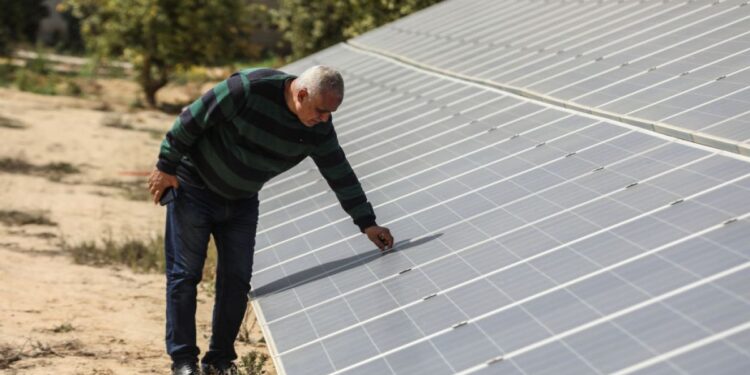Thanks to its clear skies, vast desert lands, and advanced electricity network, Egypt has all the necessary ingredients to achieve a massive expansion in electricity generation from solar energy, but it has only now moved to exploit this potential after the natural gas import bill has risen to high levels.
The sharp decline in domestic gas production, coupled with the increase in consumption, caught the authorities by surprise last year and caused frequent power outages during the hot summer.
Alarm bell
“It was a massive wake-up call and that is why the government recently announced a large emergency package,” said Ahmed Mortada, head of Egypt’s energy department at the European Bank for Reconstruction and Development.
Egypt was forced to spend more than a billion dollars more than it expected to import liquefied natural gas last year, and analysts estimate that it will spend billions more in 2025.
Solar companies say they can provide electricity much cheaper than electricity generated using gas turbines, using cheap panels from China, but they complain that market-distorting energy subsidies and restrictive regulations are hindering the expansion of solar generation. .
During a press conference last December, Hussein Al Nowais, Chairman of the Board of Directors of the Emirati Renewable Energy Company EMEA Power, pointed to Egypt’s distinguished resources in terms of solar energy and land.
New projects
EMEA Power opened a $500 million, 500-megawatt solar power plant in Aswan, 650 kilometers south of Cairo, last month, and intends to build a second 1,000-megawatt plant nearby.
Al Nowais said that the company will initially spend $300 million of its own money so that it can begin building the new station before reaching a final financing agreement by next May, and that production in the second station is expected to begin by the first quarter of 2026.
Al Nowais added that the cost of electricity produced at the two IMEA solar power stations will range between two and three US cents per kilowatt hour, noting that the cost “will certainly be cheaper than gas stations.”
According to sources working in the energy sector, it is difficult to calculate the cost of generating electricity using gas turbines, because subsidized price brackets distort the system, but one producer estimated the production cost at between 7 and 9 cents per kilowatt hour.
The state-owned Egyptian General Petroleum Corporation buys gas from local producers at below market price and then sells it to power plants at an additional discount.
State distribution companies are selling electricity to the end consumer at lower prices again, even after the consumption price for some families increased by up to 50% last year.
Emma Power is one of 3 producing companies planning to establish major solar plants to feed Egypt’s energy grid directly with electricity.
The Norway-based Scatec company signed an agreement in September for a project with a production capacity of 1,000 megawatts, while a consortium that includes the Emirati companies Infiniti and Masdar and the Egyptian company Hassan Allam signed an agreement in November to generate 1,200 megawatts of energy.
But Al Nowais suggested that Egypt would need thousands more megawatts to meet demand in the coming years.
Obstacles
Sources familiar with the energy sector say that one of the reasons for Egypt’s slow transition to solar energy is that various government departments have little incentive to focus on the total cost of energy.
“The problem with Egypt is that it is a collection of islands,” said Yassin Abdel Ghaffar of Solaris Egypt, which mainly provides solar energy to private companies. “There is no central approach for ministers to coordinate among themselves.”
In early 2024, a law was enacted allowing private energy producers to provide electricity to businesses, including factories, although they will initially only accept projects of 500 megawatts nationwide.
Prime Minister Mostafa Madbouly said in November that Egypt seeks to increase the share of renewable energy sources in the electricity mix to 42% by 2030, compared to the current 11.5% generated by solar, wind, and hydroelectric energy.
Murtada said that the government is looking for international support to strengthen the network and expand it to include solar energy production sites, and that the European Bank for Reconstruction and Development is examining how to provide assistance.
As renewable energy enters the market, Egypt plans to gradually close older and less efficient power plants.
Another obstacle to the expansion of solar energy is a regulation that prohibits consumers, who mainly live in city apartments, from installing two-way electricity meters unless they own the entire building.
These meters would allow them to add supplies to the network or purchase those supplies for their own consumption.
According to an estimate by Ayman Rasekh, CEO of Solar Soul, which provides services to homes and companies, solar energy will become available to home consumers when the price of electricity from the government network rises to more than 3 or 4 pounds per kilowatt hour.
Currently, the wealthiest families pay 2.35 pounds ($0.0462) for their electricity consumption per kilowatt hour.
The International Monetary Fund, which provides loans to Egypt, requires reducing energy subsidies.
Rasekh said: “When the government lifts electricity subsidies, you will see solar panels on the roofs of houses as you now see satellite television dishes.”



